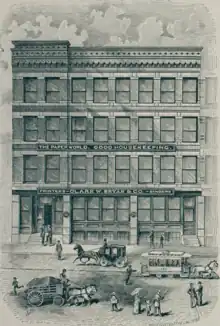Clark W. Bryan
Clark W. Bryan was a publisher, writer, poet, and journalist who is best known today for creating the home economics magazine Good Housekeeping that he would manage from 1885 until his death in 1899, during which time he published more than a hundred of his own poems in its issues.[1] Prior to this, Bryan was extensively involved in the reorganization of the Springfield Republican as editorial and business partner to Samuel Bowles, following the death of Bowles' father; Bryan entered the business in 1852 serving as partner in the paper's printing firm Samuel Bowles and Co. Upon Bowles' dissolution of the partnership with himself and several other minor shareholders in his paper's printing business, Bryan went on to rechristen it the Clark W. Bryan & Co., which purchased and expanded the Springfield Union from 1872 to 1882 when it was sold to its editor-in-chief Joseph Shipley.[2][3]
Clark W. Bryan | |
|---|---|
 Photographic portrait of Clark W. Bryan, c. 1891 | |
| Born | August 12, 1824 |
| Died | January 23, 1899 (aged 74) |
| Children | 2 |

From 1880 until his death Bryan was also responsible for a successful trade publication, The Paper World, which was published in various iterations in Holyoke, Springfield, and finally out of the Pulitzer Building in New York City. By the time the paper had been moved to the latter in 1898, Bryan retained little more than creative input,[4] and this sale to a separate company would ultimately fail.[5][6] Bryan, who had lived to see his business empire in financial ruin, and wife and one of his sons had passed in recent years, took his life on January 23, 1899, with a pistol. All of his publications were promptly discontinued, the sole exception being Good Housekeeping, which immediately found a purchaser, John Pettigrew, who would sell it to his printer George D. Chamberlain, who in turn sold it to E. H. Phelps, another former Springfield Republican associate, whose company, Phelps Publishing, had offices in Springfield and New York. Gradually reaching national prominence, it was purchased by the Hearst Corporation in 1911.[1][7]
Selected works

The following is a list of those works authored by Bryan himself, it does not include the many publications which his company would publish for which he had no editorial role–
Books
- Through the Housatonic Valley to the Hills and Homes of Berkshire (1882)
- Credit; Its Meaning and Moment (1883)
- Progress of American Journalism as Illustrated by the Reminiscences of Horace Greeley, and a Review of the New York Tribune (1885)
- The Book of Berkshire (1886)
- Carriage Driving in and near unto Western Massachusetts (1892)
Serial publications
- Springfield Union (owned and operated from 1872 to 1878)
- The Paper World (1880–1899)
- The Manufacturer and Industrial Gazette (c. 1881)
- Good Housekeeping (1885–1899)
- The Library Bulletin (1887–1898), published for Springfield City Library; often contained literary content by Bryan including excerpts from The Paper World and Good Housekeeping
- Amateur Gardening
References
- Mott, Frank Luther (1968). A History of American Magazines, 1905–1930. Cambridge, Mass.: Harvard University Press. p. 132. ISBN 9780674395541.
- Hannan, Caryn (2008). "Bowles, Samuel". Connecticut Biographical Dictionary. Vol. 1. State History Publications, LLC. p. 145. ISBN 9781878592590.
- Clogston, William (1884). King's Handbook of Springfield, Massachusetts. Springfield, Mass.: Moses King. p. 292.
- "Journalistic Notes". The Publishers' Weekly. No. 1356. January 22, 1898. p. 104.
The paper will be issued from the Pultizer Building, and although Clark W. Bryan, the founder and hitherto editor of The Paper World, has no longer any direct financial interest in the publication, he will still continue to contribute special articles to its columns from time to time
- "The Paper World's Removal to New York". Fourth Estate: A Weekly Newspaper for Publishers. Vol. IX, no. 203. New York. January 13, 1898. p. 2.
- "Clark W. Bryan's Suicide". Waterbury Evening Democrat. Waterbury, Connecticut. January 24, 1899. p. 6.
- Magda Ibrahim (February 12, 2015). "Magazines ABCs: Women's monthlies led by Good Housekeeping". MediaWeek. Retrieved April 24, 2016.